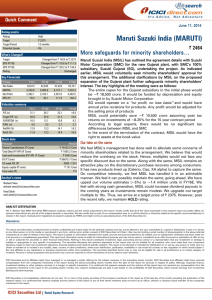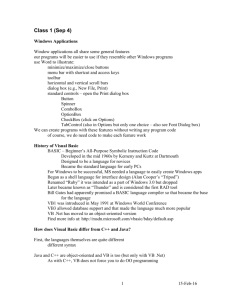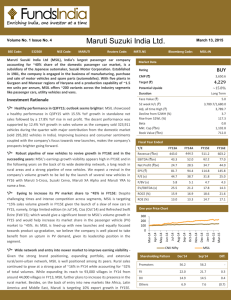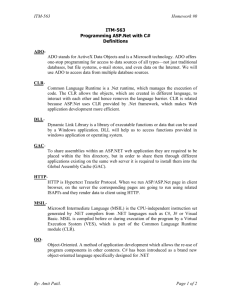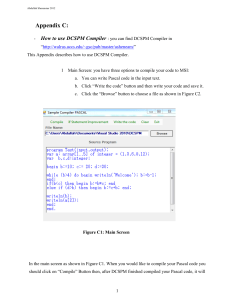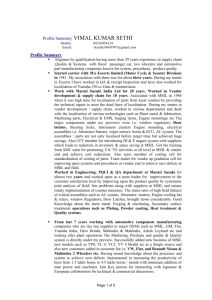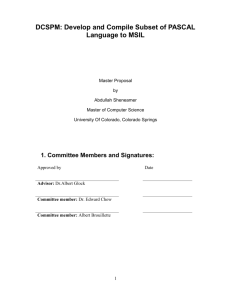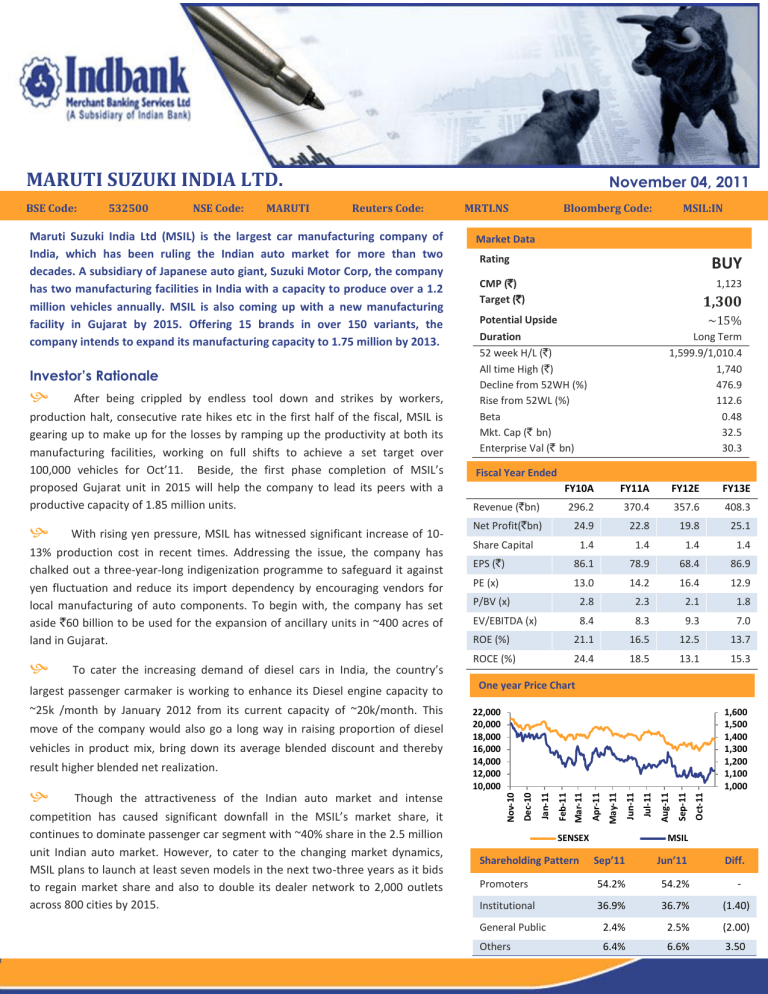
MARUTI SUZUKI INDIA LTD.
largest passenger carmaker is working to enhance its Diesel engine capacity to
~25k /month by January 2012 from its current capacity of ~20k/month. This
move of the company would also go a long way in raising proportion of diesel
vehicles in product mix, bring down its average blended discount and thereby
result higher blended net realization.
Though the attractiveness of the Indian auto market and intense
competition has caused significant downfall in the MSIL’s market share, it
continues to dominate passenger car segment with ~40% share in the 2.5 million
unit Indian auto market. However, to cater to the changing market dynamics,
MSIL plans to launch at least seven models in the next two-three years as it bids
to regain market share and also to double its dealer network to 2,000 outlets
across 800 cities by 2015.
1,300
~15%
Potential Upside
Duration
52 week H/L (`)
All time High (`)
Decline from 52WH (%)
Rise from 52WL (%)
Beta
Mkt. Cap (` bn)
Enterprise Val (` bn)
Long Term
1,599.9/1,010.4
1,740
476.9
112.6
0.48
32.5
30.3
Fiscal Year Ended
FY10A
FY11A
FY12E
FY13E
Revenue (`bn)
296.2
370.4
357.6
408.3
Net Profit(`bn)
24.9
22.8
19.8
25.1
1.4
1.4
1.4
1.4
EPS (`)
86.1
78.9
68.4
86.9
PE (x)
13.0
14.2
16.4
12.9
P/BV (x)
2.8
2.3
2.1
1.8
EV/EBITDA (x)
8.4
8.3
9.3
7.0
ROE (%)
21.1
16.5
12.5
13.7
ROCE (%)
24.4
18.5
13.1
15.3
Share Capital
One year Price Chart
22,000
20,000
18,000
16,000
14,000
12,000
10,000
1,600
1,500
1,400
1,300
1,200
1,100
1,000
SENSEX
Shareholding Pattern
Oct-11
To cater the increasing demand of diesel cars in India, the country’s
1,123
Sep-11
13% production cost in recent times. Addressing the issue, the company has
chalked out a three-year-long indigenization programme to safeguard it against
yen fluctuation and reduce its import dependency by encouraging vendors for
local manufacturing of auto components. To begin with, the company has set
aside `60 billion to be used for the expansion of ancillary units in ~400 acres of
land in Gujarat.
CMP (`)
Target (`)
Aug-11
With rising yen pressure, MSIL has witnessed significant increase of 10-
BUY
Jul-11
After being crippled by endless tool down and strikes by workers,
production halt, consecutive rate hikes etc in the first half of the fiscal, MSIL is
gearing up to make up for the losses by ramping up the productivity at both its
manufacturing facilities, working on full shifts to achieve a set target over
100,000 vehicles for Oct’11. Beside, the first phase completion of MSIL’s
proposed Gujarat unit in 2015 will help the company to lead its peers with a
productive capacity of 1.85 million units.
Rating
Jun-11
MSIL:IN
Market Data
Apr-11
Investor’s Rationale
Bloomberg Code:
May-11
Maruti Suzuki India Ltd (MSIL) is the largest car manufacturing company of
India, which has been ruling the Indian auto market for more than two
decades. A subsidiary of Japanese auto giant, Suzuki Motor Corp, the company
has two manufacturing facilities in India with a capacity to produce over a 1.2
million vehicles annually. MSIL is also coming up with a new manufacturing
facility in Gujarat by 2015. Offering 15 brands in over 150 variants, the
company intends to expand its manufacturing capacity to 1.75 million by 2013.
MRTI.NS
Mar-11
Reuters Code:
Jan-11
MARUTI
Feb-11
NSE Code:
Dec-10
532500
Nov-10
BSE Code:
November 04, 2011
MSIL
Sep’11
Jun’11
Diff.
Promoters
54.2%
54.2%
-
Institutional
36.9%
36.7%
(1.40)
General Public
2.4%
2.5%
(2.00)
Others
6.4%
6.6%
3.50
MSIL gears up to tackle accumulated backlogs
After witnessing losses to the tune of `22 billion due to labour
unrest in Q2FY12, the India's biggest carmaker is racing ahead to
clock its highest production of over 100,000 vehicles in Oct’11,
ensuring timely deliveries and promises to its customers.
Endless tool down and strikes by workers of MSIL at both Manesar
and Gurgaon plant has resulted in 24% decline in Jul-Sep’11
production, the steepest percentage decline in the company's 29year history. As a result, backlog of bookings witnessed high
accumulation, especially for its hatchback Swift for which the
waiting list has grown to more than 100,000 units. However, with
Manesar strike being resolved conditions have come back to normal
and the company is working on full shifts, to meet the pent-up
demand. As a special effort to meet the exceptional demand for
Swift, MSIL is also streamlining operations of all three plants, in
Gurgaon and in the two plants in Manesar, to roll out maximum cars
to meet domestic demand and export commitments. MSIL is also
pacing up to save its domestic market share that plunged under 40%
for the first time ever in this fiscal, forcing it to focus on new product
launches.
Strategic reduction in imports to hedge against rising
Japanese Yen pressure in long run
MSIL, the nation’s biggest car maker’s direct import of raw material
content swings in the range of 8-9% of net sales while it has ~15%
import dependency on indirect content from its Japanese parent
Suzuki Motor Corp. MSIL has a high localization of ~95-96% but its
vendors imprt components and the company pays vendors for the
cost incurred because of currency fluctuations. Besides, the
company makes royalty payments of ~5-6% of its net sales to its
parent company in Japan. As a result, MSIL has a total exposure of
~30% to the Japanese Yen while, it generates only about 9% of its
revenue from exports.
In the quarter ended September 2011, yen has strengthened 20%
against the Indian currency, resulting in ~ `270 million growth in
MSIL aims 30-40% higher production for Oct’11 to meet
accumulated order backlog
120,000
17,000-18,000 to
be comprised of
Swift alone
102,200
100,000
80,000
73,000
60,000
40,000
20,000
0
Sep'11
Oct'11E
Total production of cars
Japanese Yen rises 20% against Indian rupee in Jul-Sep’11
0.66
0.64
0.62
0.6
0.58
0.56
0.54
0.52
Rupee/Yen
MSIL’s import cost. The recent run in the Japanese currency has significantly increased production costs of the passenger car
manufacturer by 10-13%. The impact of the stronger yen has turned more worry some for MSIL because rising competition is preventing
the company from raising car prices to offset cost increases at a time when growth in car sales is slowing because of higher fuel prices
and rising interest rates on automobile loans.
Addressing the issue of rising import cost of components, the company has started a three-year-long indigenization programme to
reduce its dependency on imports and safeguard it against a rising yen. Under the proposed strategy, MSIL would encourage vendors to
produce more parts locally by helping them in doing more and more research and development activity in India and asking the joint
venture partners of Indian vendors to produce more and more components in India. This will help the company to reduce import of parts
to 7-8% over the next three years and also save at least `1.50 billion every year. The proposed move in long run will not only help the
company to minimize the impact of yen fluctuation in its earnings but will also eliminate the import duty and freight expenses from its
cost basket.
Increased focus on Swift diesel version to lead
the momentum
India is a price sensitive market and the sudden upturn in the
prices of petrol has soared up the sales volume of diesel variants
small cars in the country. In the first half of the current fiscal,
the auto makers of the country has seen the diesel to petrol
ratio go up from 60:40 to 85:15.
To cater the increasing demand of diesel cars in India, the
country’s largest passenger carmaker is working to enhance its
Diesel engine capacity to ~25k /month by January 2012 from its
current capacity of ~20k/month. The company also intends to
increase the production of diesel vehicle proportionately from
its current ~21% to ~26% of the overall production volume in
FY13E, thereby, enhancing the product mix. With higher
proportion of diesel vehicles in its portfolio, MSIL will also be
able to bring down its average blended discount in the coming
quarters.
MSIL Swift dominates the premium hatchback segment in India
MSILSwift
11%
7%
24%
Hyundai i20
12%
Ford Figo
Tata Indica
MSIL RITZ
16%
15%
Volswagen Polo
15%
Others
MSIL’s newly launched Swift has received a good response in the domestic market and it already has an order backlog of ~1 lac units,
out of which ~88% is diesel. To meet the pent-up demand for its diesel swift, MSIL has decided to significantly reduce the exports of
diesel engine of ~35K to 45K diesel engines to Hungary to almost negligible levels in the next six months and move the additional
engines after export cut for enhanced production of Swift. Besides, MSIL is also working on an agreement with Fiat to source diesel
engines in the next two months for increasing the production of its popular compact car Swift. On the materialization of the deal, the
company intends to roll out ~20,000 units of Swift every month against it’s before strike productivity level of 18,000 units per month.
Dominant market position
After rolling out its first car, the little Maruti 800, in 1984, MSIL
has dominated the Indian passenger car market for almost two
decades. Though the attractiveness of the Indian auto market
and intense competition caused a significant downfall in the
MSIL’s market share, it continues to dominate passenger car
segment with ~40% share in the 2.5 million unit Indian auto
market. However, to cater to the changing market dynamics,
MSIL plans to launch at least seven models in the next two-three
years as it bids to regain market share. The company also wants
to double its dealer network to 2,000 outlets across 800 cities by
2015 and enhance its footprints in all places with a population in
excess of 50,000. At present, MSIL has ~970 outlets covering 643
cities, which is almost three times that of second-placed
Hyundai’s 340 dealers in 224 cities.
MSIL leads the race in the domestic passenger car segments
10%
MSIL
30%
Hyundai
40%
Others
20%
Tata Motors
New plant in Gujarat to cause two-fold growth in productivity
India’s largest car maker intends to purchase ~1400 acres of land in Gujarat to establish a new plant with an initial capacity to produce1
million units by 2015. Under the proposed investment of approximately `180 billion in the region to build additional capacity, `60
billion are likely to be used for the expansion of ancillary units in ~400 acres of land. This move of the company would not give MSIL
proximity to the ports in Gujarat, ensuring quicker and more efficient exports but will also help the company to strengthen its market
position by increasing its production capacity to 3 million units by 2015 from around 1.4 million at present.
Capacity expansion
Capacity addition at Manesar unit to strengthen
market position
After rolling out out nearly 9.5 lakh units from its Gurgaon
facility and 3.5 lakh units from the existing Manesar plant in
FY11, MSIL is working set up two new plants in Manesar with
2.5 lakh annual capacity each at a total investment of `36
billion. The first phase expansion of its Manesar unit was
completed in October this year, while other assembly line is
expected to be completed by September 2012. After the
completion of the capacity enhancement at all the three units
of the company, MSIL’s output at Manesar is expected to reach
850,000 units a year. Beside, the first phase completion of its
proposed Gujarat unit in 2015, MSIL will lead its peers with a
productive capacity of 1.85 million units.
2,000
1,800
1,600
1,400
1,200
1,000
800
600
400
200
0
120%
100%
80%
60%
40%
20%
0%
FY08
FY09
FY10
FY11
FY12E
Installed capacity ('000 units)
FY13E
Capacity Utilization % - RHS
Capital expenditure to grow ~two-fold in FY12
Proposed investment of `60 billion to augment
growth
7,000
6,000
5,000
4,000
`million
MSIL is planning a medium term investment of `60 billion, of
which a capital expenditure of `40 billion are likely to be set
aside in FY12 to boost its productive capacity and launch one
new model every year. Part of the proposed investment will
also be used to build five vehicle stock yards in the country
within one to two years. The company has spent ~`18 billion in
upgrading the capacity of second manufacturing unit at
Manesar, near Delhi while the third unit, which will also come
up at Manesar, will attract an investment of ~`19 billion.
Remaining funds would be utilized on a R&D facility at Rohtak
(Haryana), stock yards and brand centers.
140%
3,000
2,000
1,000
0
FY07
FY08
FY09
Capital Expenditure
FY10
FY11
FY12E
Revenue Expenditure
Q2FY12 sales volume across MSIL’s passenger car segment
120,000
112,848
100,000
80,000
60,000
44,864
40,000
20,288
20,000
4,392
54
Executive( Kizashi)
Mid-Size(SX4)
Super Compact (Dzire)
0
Compact( Swift, Estilo, Ritz)
During Q2FY12, MSIL sold 252,307 units of vehicles of which only
12% accounted for export sales. Passenger car sales accounted for
~82% of the total sales volume in India led by Mini passenger cars
like M800, Alto, A-Star and WagonR. Though MSIL’s sales volume
during the quarter declined ~20% on y-o-y basis, blended net
realization of the company during the period came higher by 4.8%
YoY and 1.1% QoQ to `298,741 per unit, due to higher proportion
of diesel vehicles in product mix (around 22% vs. 21% QoQ).
Average discounts per vehicle for MSIL in Q2FY12 were also
higher at `13,500 per vehicle vs. `9,000 per vehicle QoQ due to
lower contribution from Swift and Dzire as MSIL do not offer any
discount on these two models. Going further, with higher
proportion of diesel vehicles in its portfolio, MSIL is expected to
record high net realization and bring down its average blended
discount in the coming quarters.
Mini (M800, Alto, A-Star,
WagonR)
Improved net realization to be sustained in
coming quarters
Service Center ~ an unparallel edge
Maruti is aggressively widening its sales and service network, providing the unparallel edge over its other peers. In FY’11 the company
added over 191 sales outlets taking the total tally just below 1,000 marks at 993 outlets covering over 660 cities across India. It
increased service outlets by 206 to 2,946 outlets in 1,395 cities. While the arch rival Hyundai motors have over 400 sales outlooks tied
with 700 service networks. Over the past several years, contribution from rural sales witnessed a sequential increment, contributing
over 20% to domestic sales. About 40% of MSIL's sales outlets are in the rural format, with scaled-down investment, enabling viability
on lower volumes.
MSIL's network services ~1.2m vehicles a month. With an increasing service load, MSIL turned its focus to impart training and initiated
tie-ups with 28 ITIs (Industrial Training Institutes) to increase technical staff at workshops.
Unparallel edge of wide sales and service network
2946
2740
2767
2628
800
555
1,200
1,000
800
700
600
454
312
600
227
400
400
300
375
600
600
800
1,500
500
681
393
1,000
668
1,000
491
2445
2,000
1,092
1,200
1,400
1,220
2096
2,500
1,172
1,600
802
1,314
3,000
1,335
1,395
993
3,500
400
200
200
500
100
200
0
0
FY06
FY07
FY08
Service Centre
FY09
FY10
0
0
FY06
FY11
Cities Covered
FY07
FY09
Showroom
Increased focus on alternative fuel technology
FY10
FY11
Cities Covered
Alternative fuel cost
5
4.65
4.5
4
3.5
`/km
To counter the ever rising fuel cost, the company has been
continuously focusing on fuel efficient cars and simultaneously
incorporating alternative fuel technology. Sales have risen of
vehicles powered by alternative fuels due to rising petrol prices.
The diesel proportion of volumes increased from 60% to over 80%
among available models. Considering capacity constraints for
diesel engines, MSIL will increase its diesel-engine capacity (in the
SPV - Suzuki Powertrain) from 0.25m to 0.29m units. The company
is focused on promoting CNG cars. It’s i-GPI CNG technology
delivers higher fuel efficiency than conventional CNG cars. Besides,
the loss of power, compared with gasoline engine cars is negligible
in the case of i-GPI, a shortcoming of conventional CNG
technology. MSIL believes that once CNG availability improves in
India, it could become a popular option due to its low cost and
environment friendliness. MSIL also launched an LPG version of
WagonR with SET (Smart Efficient Technology) and a diesel version
of the SX4 with a super-turbo diesel engine.
FY08
3
2.7
2.4
2.5
2
1.5
1.5
1
0.5
0
Petrol
LPG
Diesel
CNG
Indian Automobile Industry
An overview of Indian Automobile Industry
The Indian automobile industry, with an estimated current turnover of `1,821 billion, stands out to be the seventh largest in the world,
accounting for nearly 6% of the country’s GDP. The sector has witnessed phenomenal growth over the last ten years, supported by a
slew of new product introductions by vehicle manufacturers and growing consumer confidence. A robust transportation system plays a
key role in the country's rapid economic and industrial development, and the well-developed Indian automotive industry justifies this
catalytic role by manufacturing over 17.5 million vehicles and exporting about 2.33 million every year, with 76% dominance of twowheelers in the market share of the industry.
YTD sales growth moderates on rising consumer
borrowing cost
In the first five months of FY12, the industry witnessed cumulative
production growth of 15.92% despite persistent pressure of high
finance cost, high commodity prices and high fuel prices.
Meanwhile, sales growth on home ground reported sluggish at
13.26% due to rising consumer borrowing cost. During April-August
2011, the passenger vehicles segment of the country grew
marginally at 1.94% while commercial Vehicles segment registered
growth of 17.80%, pushed by 27.44% growth Light Commercial
Vehicles sales. Three Wheelers sales recorded de-growth of 0.27%
while two wheelers growth numbers fueled up to 15.94%, helped by
13.64% and 15.71% sales growth in Scooters and Motorcycles
segment, respectively. At the same time, overall automobile exports
rose 30.93%.
India pool global auto manufacturers as the
favourite destination
In recent times India has emerged as one of the favorite investment
destinations of global automobile manufacturers like Nissan and
Ford due to the availability of trained and skilled manpower at
competitive costs. French car maker, Renault SA is planning to make
India an exclusive manufacturing and export hub for its sport utility
vehicle, Duster. To occupy the top position in the Indian luxury
segment, German auto major, Mercedes Benz is planning to
introduce up to 10 new brands in the next three years in India.
Meanwhile, leading luxury car brand, BMW has lined up a series of
new brands to be launched in the Indian sub-continent.
Outlook
Domestic market share in FY11
4.4%
16.3%
Passenger
Vehicles
3.4%
Commercial
Vehicles
Three Wheelers
76.0%
Two Wheelers
5 year production trend
3,500,000
3,000,000
2,500,000
2,000,000
1,500,000
1,000,000
500,000
0
FY06
FY07
Passenger Vehicles
FY08
FY09
FY10
FY11
Commercial Vehicles
In FY11, the industry registered a turnover of `1821 billion, reflecting a growth of 34.2 per cent with sales of 15,513,156 units. In FY12,
though some moderation in the growth rates is expected due to the successive increases in the interest rates that have made it more
expensive for the customers to purchase vehicles, the Indian automobile industry is expected to clock turnover in the range of `2,040
billion to `2,100 billion, up by 12-15 per cent. As per Society of Indian Automobile Manufacturers (SIAM) the size of the domestic
passenger vehicles market is likely to touch 5.6 million units by 2017, up from 2.2 million units per annum currently. The industry body,
which has projected a domestic sales growth of 11-13% also, hopes to see export of 1.3 million units in the next 5 years.
Balance Sheet (Consolidated)
(`million)
Profit & Loss Account (Consolidated)
FY10A
FY11A
FY12E
FY13E
FY10A
FY11A
FY12E
FY13E
1,450.0
1,450.0
1,450.0
1,450.0
Operating Income
296,230.0
370,400.0
357,691.5
408,311.7
Reserve and surplus
116,910.0
137,230.0
157,074.2
182,263.4
Operating Expenses
256,720.0
333,760.0
324,550.0
365,910.0
Net Worth
118,360.0
138,680.0
158,524.2
183,713.4
EBITDA
39,510.0
36,640.0
33,141.5
42,401.7
Loan funds
8,210.0
3,090.0
7,750.0
7,750.0
EBITDA Margin (%)
13.6
10.1
9.5
10.7
Deferred Tax Liability
1,370.0
1,640.0
1,640.0
1,640.0
Depreciation
8,250.0
10,140.0
11,210.0
12,886.7
Capital Employed
127,940.0
143,410.0
167,914.2
193,103.4
EBIT
31,260.0
26,500.0
21,931.5
29,515.0
Gross fixed assets
104,070.0
129,540.0
160,100.0
187,320.0
EBIT Margins (%)
10.8
7.3
6.3
7.4
Less: acc. depreciation
53,820.0
63,960.0
75,170.0
88,056.7
Interest
340.0
240.0
370.0
530.0
Net Fixed assets
50,250.0
65,580.0
84,930.0
99,263.3
Other Income
5,000.0
4,820.0
6,000.0
6,000.0
3,880.0
4,000.0
4,500.0
4,500.0
PBT
35,920.0
31,080.0
27,561.5
34,985.0
Total Fixed Assets
54,130.0
69,580.0
89,430.0
103,763.3
Tax
10,950.0
8,200.0
7,717.2
9,795.8
Investment
71,770.0
51,070.0
51,070.0
51,070.0
Net Profit
24,970.0
22,880.0
19,844.2
25,189.2
2,050.0
22,760.0
27,414.0
38,270.0
Net Profit Margin (%)
8.6
6.3
5.7
6.3
127,940.0
143,410.0
167,914.2
193,103.4
Share Capital
Capital WIP
Net Current Assets
Capital Deployed
(`million)
Valuation
Key Ratios
FY10A
FY11A
FY12E
FY13E
EBITDA Margin (%)
13.6
10.1
9.5
10.7
EBIT Margin (%)
10.8
7.3
6.3
7.4
NPM (%)
8.6
6.3
5.7
6.3
ROCE (%)
24.4
18.5
13.1
15.3
ROE (%)
21.1
16.5
12.5
13.7
EPS (`)
86.1
78.9
68.4
86.9
CEPS(`)
114.6
113.9
107.1
131.3
P/E (x)
13.0
14.2
16.4
12.9
BVPS
408.1
478.2
546.6
633.5
P/BVPS (x)
2.8
2.3
2.1
1.8
EV/Operating Income (x)
1.1
0.8
0.9
0.8
EV/EBITDA (x)
8.4
8.3
9.3
7.0
The worst seems to be over for the company, with prolonged
labour problems at both Manesar and Gurgaon plant finally
comes to an end, the management is confident to bring the
production level back on track by December 2011, with festive
season going on, the sales volumes are expected to catch on.
MSIL has a long term strategy to capitalize on the prevailing
strong and steady demand for passenger vehicles in India,
driven by economic growth and lower level of penetration,
particularly in rural part of the country. The company’s strategy
to aggressively expand its capacity, increased focused on
alternative fuel technology, and unparallel network of sales &
service infrastructure would augurs well for the company in
ensuring days.
MSIL is attractively placed at P/E of ~12.9.x FY13E. Considering
the above aspects, we rate the stock as ‘BUY’ at the current
market price of `1,123.
Indbank Merchant Banking Services Ltd.
I Floor, Khiviraj Complex I,
No.480, Anna Salai, Nandanam, Chennai 600035
Telephone No: 044 – 24313094 - 97
Fax No: 044 – 24313093
www.indbankonline.com
Disclaimer
@ All Rights Reserved
This report and Information contained in this report is solely for information purpose and may not be used as an offer document or solicitation
of offer to buy or sell or subscribe for securities or other financial instruments. The investment as mentioned and opinions expressed in this
report may not be suitable for all investors. In rendering this information, we assumed and relied upon, without independent verification, the
accuracy and completeness of all information that was publicly available to us. The information has been obtained from the sources that we
believe to be reliable as to the accuracy or completeness. While every effort is made to ensure the accuracy and completeness of information
contained, Indbank Limited and its affiliates take no guarantee and assume no liability for any errors or omissions of the information. This
information is given in good faith and we make no representations or warranties, express or implied as to the accuracy or completeness of the
information. No one can use the information as the basis for any claim, demand or cause of action.
Indbank and its affiliates shall not be liable for any direct or indirect losses or damage of any kind arising from the use thereof. Opinion
expressed is our current opinion as of the date appearing in this report only and are subject to change without any notice.
Recipients of this report must make their own investment decisions, based on their own investment objectives, financial positions and needs of
the specific recipient. The recipient should independently evaluate the investment risks and should make such investigations as it deems
necessary to arrive at an independent evaluation of an investment in the securities of companies referred to in this document and should
consult their advisors to determine the merits and risks of such investment.
The report and information contained herein is strictly confidential and meant solely for the selected recipient and is not meant for public
distribution. This document should not be altered in any way, transmitted to, copied or distributed, in part or in whole, to any other person or
to the media or reproduced, duplicated or sold in any form.

